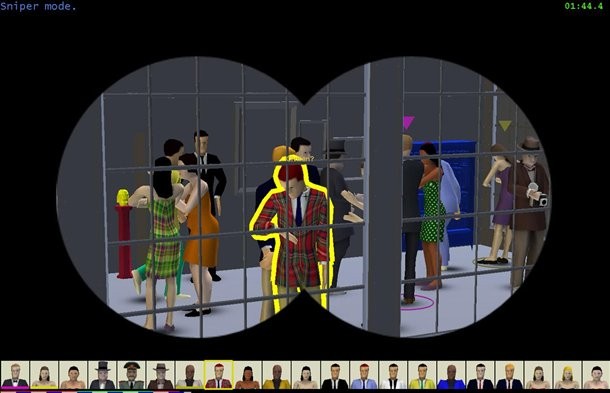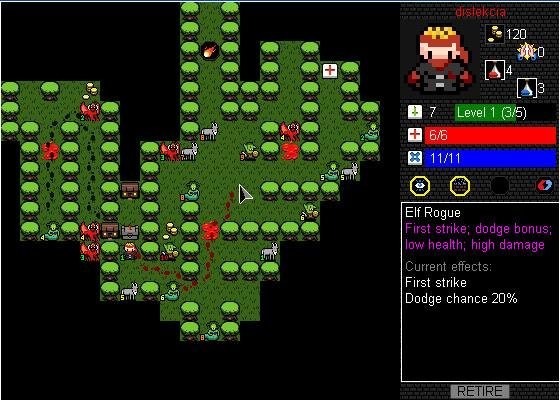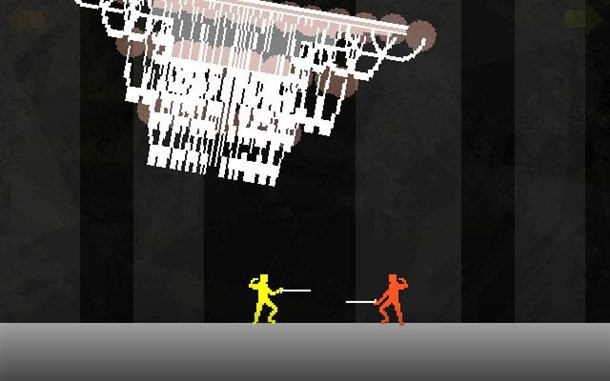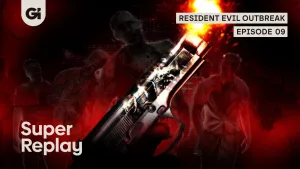Indie Week Day Seven: Seumas McNally Grand Prize

[Welcome to Indie Week at gameinformer.com. We’ve got a full seven days of indie game coverage leading up to the 2011 Independent Games Festival Awards. Check back daily for coverage of the top independent games of the year.]
The Seumas McNally Grand Prize is awarded each year to a title that most exemplifies independent development - a top contender in terms of innovation, quality, impressiveness, and overall enjoyment. With $20,000 on the line, a nomination isn’t to be taken lightly.
The inherent weight of the award required a larger pool of judges with an equally broad range of specialties to determine the winner. Jurists were drawn from all of the festival’s specific categories, and notable names include Andy Schatz, who took home the IGF grand prize in 2010 for this stealth title Monaco, Phil Fish (Fez), Edmund McMillen (Super Meat Boy), Ron Carmel (World of Goo), and Dylan Cuthbert (Founder, Q-Games).
Additional judges were found in Kyle Gray (Henry Hatsworth), Robin Hunicke (ThatGameCompany), Kris Piotrowski (Might and Magic: Clash of Heroes), Petri Purho (Crayon Physics Deluxe), Margaret Robertson (Development Director at Hide & Seek), Adam Saltsman (Co-founder, Semi Secret Software), Mare Sheppard (Metanet Software Inc.), Randy Smith (Spider: The Secret of Bryce Manor), Nathan Vella (Co-founder, Capybara Games), Jakub Dvorsky (Machinarium), Kyle Gabler (World of Goo), Raigan Burns (N+), Andy Nealen (Hemisphere Games), Tommy Refenes (Super Meat Boy), Danny Baranowski (Composer, Super Meat Boy), Frank Lantz (Co-founder, Area/Code), and Paolo Pedercini (Molleindustria). The immense and diverse talent found in the grand prize jury makes even more apparent what an honor the award is for the developer who secures it.
The five titles nominated for the 2011 Seumas McNally Grand Prize excel in all the areas detailed above. As such, the bulk are nominated for several IGF awards and were previewed earlier this week. Due to the caliber of the prize, we've opted to repost the original previews in one convenient locaton. If you've been following us all week, make sure to read up on SpyParty (Page 2) before checking in tonight for a list of the IGF winners. If not, get the scoop on the top five nominees below.
A WORD FROM THE IGF JUDGES: "Frictional Games' first person horror-adventure Amnesia was praised for its 'interesting, visceral, tactile interface' and 'incredible atmosphere and tension.' Wrote one jurist: 'I can't play it more than an hour at a time, even though I'd like to.' Meanwhile, QCF's Desktop Dungeons, mashes rogue-like and puzzle-game play in a way 'so fun and elegantly designed' that jurists didn't hesitate to deign 'pure genius.'
"Mojang's successful first person creation/excavation game Minecraft was the subject of much discussion across the board, with the Grand Prize jury concluding that it should be noted as a familiar its table-turning design: 'Instead of spending hundreds of millions of dollars to craft a lavishly decorated stage set on which the player has a series of entertaining experiences, Minecraft grows a complex world out of asmall set of finely-tuned rules...It shows what games are good at - abstraction, compression, emergence, boiling a worldful of psychedelic soup out of a handful of logical stones.'
"Messhof's tug-of-war fencing game Nidhogg was praised here for not just for balancing controls 'simple enough for absolute beginners, but still deep and interesting over 20 minutes,' but for 'the fact that it's also an amazing spectator sport' - 'a public spectacle where 2 people battle to the death while a blood-thirsty crowd cheers on.'
"And finally, the jury called Chris Hecker's Spy Party 'one of the most original and fun multiplayer experiences I've had since Street Fighter 2,' and 'the pinnacle of independent game development: an insane idea wrapped in crazy accessibility issues tied around something that seems impossible to market, which ends up being one of the most interesting, sublime, intense and FUN gaming experiences you can have.'"

AMNESIA: THE DARK DESCENT
Developer: Frictional Games
Platform: Windows, Mac, Linux
Release Date: Available Now
Price: $19.99
Note: This article originally appeared in the March 2011 issue of Game Informer (#215)
A first-person survival horror title with an emphasis on atmosphere, Amnesia: The Dark Decent is the brainchild of Penumbra creators Frictional Games. Amnesia places you in the shoes of Daniel, a protagonist aloof from his current circumstances due to a case of self-inflicted memory loss. Wandering aimlessly through a dilapidated Prussian castle, letters penned in his own hand indicate that some things are perhaps best left forgotten. Daniel’s more cognate self assures him through written instructions that finding a man deep within the castle named Alexander, and subsequently murdering him, will set everything right.
Odd happenings occur at around corner and vastly effect the way the game is played. If Daniel spends too long in the dark he will begin to madden – is sanity slipping in tandem with the source of light. Matches and lantern fuel are commodities to be fiercely protected. Unnerving events – objects moving unaided or disembodied voices echoing through the dank halls – will also cause Daniel’s sanity to slip. When his mental faculty dips into dangerous territory, the floor will begin to waver, walls pulse, and his head spin. The effect is disorienting and makes even more difficult to discern between what is real, and what is a result of Daniel’s fevered frenzy. Lurking enemies make exploration unnerving, as one never knows what sort of horror waits patiently around the bend.
Extremely polished for an indie title, Frictional powers its games with proprietary technology created by a studio of around five fulltime staffers. Amnesia: The Dark Descent has received positive reviews across the board, with many counting it among the most terrifying games they’ve ever encountered. See for yourself below.
[Next up: Test your skill in SpyParty]

SPYPARTY
Developer: Chris Hecker
Platform: PC
Release Date: TBA
Price: TBA
Note: This article originally appeared in the March 2011 issue of Game Informer (#215)
While SpyParty is more prototype than a fully realized game, the potential behind the unique concept is immediately apparent. A skill-based espionage game, winning is completely contingent on one’s power of observation and ability to catalogue subtle human behavior. Unfolding during a high society cocktail party, the scenario is a typical cat and mouse tale, with the player taking on the role of a sniper or a spy. Standard party etiquette dictates that attendees will converse casually, sip drinks, gaze at scenery, and examine art. As a spy amongst the throng of elite, you must practice these behaviors and manipulate them and the environment to your own end. Moving with confidence is key to surviving long enough to complete four goals – bugging the ambassador, stealing a small statue, making contact with a double agent, and transferring microfilm between two marked books. Each action has an associated tell, and a pair of eyes are always on the lookout for such standout behavior.
As the sniper, the player must observe the party, identify the spy, and eliminate them once confident in their intel. Always on the outside looking in, the sniper must search for telltale signs that give away the conspirator’s identity. A barrage of sights and sounds may overwhelm the sniper at first, but out of place behavior will be apparent to a discerning eye.
Experience is key to playing SpyParty successfully. Hecker has been quite transparent about his “depth-first, accessibility later” development model, making known that depth and replayability is paramount to accessibility in this early stage. If you’ve played even a handful more rounds than your opponent, chances you will best them in this skill-driven game.
All of Spy Party’s art, audio, and interfaces are placeholder assets for the time being, so the game isn’t much to look at. That being said, the unique emphasis on behavior, perception, and ultimately deception makes it a standout title worthy of recognition.
[Next up: Take a coffee break with Desktop Dungeons]

DESKTOP DUNGEONS
Developer: QCF Design
Platform: Windows, Mac
Release Date: Available Now
Price: Free
Note: This article originally appeared in the March 2011 issue of Game Informer (#215)
Desktop Dungeons takes the heart of the RPG subgenre roguelike and distills it into a short and sweet coffee break excursion. The finely-tuned balance of superficial fun and surprising depth makes each 5-10-minute play through unexpectedly fulfilling.
Every adventure starts the player as a level one character that must explore vast dungeons, best foes, gain experience, scavenge loot, purchase equipment, maintain piety from the gods, and ultimately prepare to take on a level ten boss.
Unexplored territory within a dungeon is valuable, as uncovering new ground via adjacent tiles renews both the player’s health and mana reserves. In this regard, exploration is an art form. One must navigate about uncovered territory to attack monsters within their skill range, level up, heal through uncovering more tiles, and then begin the process of boosting their XP once again. The result feels almost like a puzzle at times, training you to explore and take on enemies in a formulaic order. Formulaic, but undoubtedly fun.
Depth of play is integrated through ailments and status changes, potions and spells, equipment and upgrades, and so on. Additionally, Desktop Dungeons derives longevity from the comprehensive race and class systems, all of which boast unique skills and unlockable challenges to further encourage replaying. If you’re like me, little encouragement will be needed to dedicate hours upon hours to Desktop Dungeons.
Check out QFC's Desktop Dungeons Survival Guide below.
[Next up: Mojang's massively successful Minecraft]

MINECRAFT
Developer: Mojang Specifications
Platform: Browser, Windows, Mac, Linux
Release Date: Beta Available Now
Price: $19.99
Note: This article originally appeared in the March 2011 issue of Game Informer (#215)
If there’s been a single Cinderella story of 2010, the distinction goes to Mojang Specifications’ Minecraft. Creator Markus “Notch” Persson first conceptualized the game in May of 2009 and it quickly garnered attention from the press and a rabid following of fans, nabbing hundreds of thousands in sales while still in alpha.
Built upon a foundation of tedium, the highly addictive and rewarding sandbox title is more a tool for one’s imagination than an explicit game. The beta tasks players with constructing environments and objects out of textures cubes harvested in a simplistic 3D world. As the name implies, mining is paramount to crafting further and further complex items. Commonplace resources such as wood and cobblestone can be processed and combined to yield swords, pickaxes, workbenches, furnaces, and more. With enough resources scavenged, both common and extremely rare, you will eventually find yourself harvesting crops, cooking food, constructing armor, and traveling the countryside by minecart.
The beta, which launched in December of 2010, introduced more traditional game elements such as multiplayer, a health bar, and hostile creatures. While the core functionality remained the same, fortification and protection became considerations in addition to one’s creative intentions. Perhaps the most impressive aspect of Minecraft, however, is the ingenuity and intelligence of its fans. Some of the most dedicated players have gone so far as to recreate BioShock’s Rapture, Portal’s Aperture Science facilities, and even a scale model of the U.S.S. Enterprise.
Having met such massive success through Minecraft, Persson founded Mojang Specifications in Stockholm, and now employs a handful of staffers who support both Minecraft and the development of a yet-to-be-announced second game. Persson promises that he will continue to develop Minecraft until it is a finished and complete experience, and that post-launch support will be maintained as long as people enjoy and purchase the game. As of January 12, Minecraft has passed one million sales. We doubt the momentum will slow anytime soon.
Check out one of Notch's own Minecraft creations below.
[Next up: Tug of war with Messhof's Nidhogg]

NIDHOGG
Developer: Messhof
Platform: PC
Release Date: TBA
Price: TBA
Note: This article originally appeared in the March 2011 issue of Game Informer (#215)
Nidhogg appears to be a simple pick-up-and-play game, but boasts a surprising amount of strategy. Described as a fencing game with light platforming elements, two individuals challenge each other locally as they vie to gain ground on their side of the screen. A quick jab to the torso will render your enemy a pile of pixels, and in the few moments between respawns ground is yours to gain. The ultimate goal is to make it to the furthest reaches of your side of the screen, where a cheering crowd celebrates your victory.
There is an inherent chaos to play, as combinations of moving, ducking, running, jabbing, sliding, and even throwing your weapon results in a constant ebb and flow of battle. You may have the advantage at one moment, but be desperately on the defensive the next. A short match could last a mere minute, but when pitted against a valiant opponent could last an eternity.
According to developer Messhof, single player and networked multiplayer are currently in development, in addition to more diverse levels. With intentionally simple graphics, sometimes eye jarring color combinations, and trance-inducing music, Nidhogg is a fast, frantic, and ultimately quirky title worth keeping an eye on.
See for yourself below.
Seumas McNally Grand Prize Honorable Mentions: Neptune's Pride (Iron Helmet Games), Super Crate Box (Vlambeer), Recettear: An Item Shop's Tale (Carpe Fulgur), Bit.Trip Runner (Gaijin Games), Retro City Rampage (Vblank Entertainment)

Get the Game Informer Print Edition!
Explore your favorite games in premium print format, delivered to your door.
- 10 issues per year
- Only $4.80 per issue
- Full digital magazine archive access
- Since 1991









